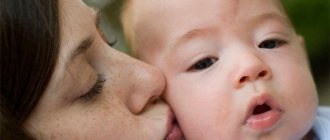Is it possible to give Glycine to children?
From the mouths of attentive mothers who are worried about the health of their baby, you can often hear the question whether Glycine is ok for children. In order to get an answer to this, you need to figure out what kind of drug it is. This medicine basically contains the essential amino acid glycine. It is always present in the body of every person. Its second name is aminoacetic acid.
Considering these features, Glycine can be called one of the safest drugs. Pediatricians often recommend it for children, regardless of age. If there are certain indications, the medicine is included in the list of medical prescriptions for the treatment of infants. Experts are completely confident in the safety of the medicine.
At what age can children be given glycine?
Among the common questions of parents whose children are prescribed the drug is at what age can Glycine be given to children and how to give it. The instructions for the medicine do not provide any information regarding the age of the patients taking it. Pediatricians often prescribe medicine to newborns and infants to normalize the functioning of the nervous system, improve brain function and normalize sleep.
Glycine is also prescribed for older children. In this case, doctors pursue the goal of improving brain activity. When taking this amino acid, there is an improvement in concentration, which has a beneficial effect on school performance. Children begin to remember information better and quickly navigate the material they have studied. In addition, the drug helps maintain the overall tone of the body.
How does Glycine affect children?
As noted above, Glycine contains the amino acid of the same name, and therefore is not capable of causing harm to the body. This substance enters the body with food. The basis of a baby’s diet is breast milk, and if there is not enough of it, the baby begins to experience a glycine deficiency, which affects the functioning of the nervous system. If we talk about how Glycine acts on infants and older children in general, it is necessary to highlight the following therapeutic effects of the drug:
- improvement of metabolism;
- eliminating anxiety;
- stimulation of brain activity;
- improved sleep;
- elimination of aggressiveness.
Glycine - indications for children
The drug can be used for both therapeutic and prophylactic purposes. However, the differences will be in the dosage and frequency of administration. The medicine is often prescribed by a neurologist. In many cases, Glycine can be prescribed, the indications for use of which are as follows:
- sleep disturbance;
- memory impairment;
- attention deficit;
- memory impairment;
- emotional instability;
- tearfulness;
- mental retardation;
- traumatic brain injuries.
Glycine is often prescribed for children in order to improve the process of adaptation in society. Many children, starting to attend kindergarten, show aggression towards the children around them. The drug helps to increase intelligence, as a result of which children begin to better seek common ground with their peers.
Glycine for children - contraindications
As noted above, the drug contains an amino acid that is harmless to the human body. Given this fact, doctors prescribe Glycine tablets to children with little or no fear. However, there are cases when taking the drug is prohibited. The main contraindication is individual intolerance. If after 1-2 doses of the medication no negative changes are observed, treatment with the drug is continued according to the regimen prescribed by the doctor.
What kind of Glycine can be given to children?
The drug is available in the form of Glycine tablets. These are small, flat, white, odorless pills with a sweetish taste. This type of medication is directly prescribed for the treatment of children. Glycine forte can also be taken by children, but in this case it is necessary to take into account a larger dosage of the medicine compared to the usual form.
Rules for dosage and administration of the drug
If an adult suffers from insomnia or sleeps poorly due to disturbing, frightening dreams, then you can take Glycine at night . In such cases, one tablet taken 30 minutes before bedtime may be sufficient. However, if the condition does not improve, you can switch to the standard method of administration - 2-3 tablets during the day, and you should still take one of the tablets in the evening.
If the child does not sleep well, then Glycine can also be given to children before bedtime. In this case, one tablet in the evening is often sufficient. Although, if the child is more than three years old and the effect is not enough, the scheme can also be used for adults. Of course, you shouldn’t expect the remedy to start working right away. Numerous reviews indicate that at least two or three days pass from the start of administration to the development of a pronounced effect.
Glycine - use for children
When prescribing the drug Glycine, the dosage for children is determined individually. The attending physician takes into account many nuances: the type of pathology, its severity, stage, features of the clinical picture. These factors have a direct impact on the course of the therapeutic process and its duration. Among the mandatory factors that are taken into account before using the drug Glycine for children:
- patient's age;
- purpose of application;
- individual reactions to the drug.
Glycine - dosage for children under one year old
Infants do not have a set daily routine, so sleep disturbances, anxiety, tearfulness, and increased excitability are common phenomena. To eliminate them and calm the child, pediatricians prescribe Glycine. Children who have not yet turned 1 year old are given 1/4–1/2 tablets at a time. Up to 3-4 doses of medication are possible per day. Due to the fact that the drug is available in tablets, there are specific features of use.

Having separated the necessary part of the tablet, it is crushed to a powder state. In order for the medicine to enter the baby’s mouth unchanged, doctors advise dipping the pacifier in the resulting powder and giving it to the child. If the baby does not take the pacifier, you can apply the medicine to the inside of the baby's cheeks with your finger, or place it under the tongue. You should not add Glycine to children under one year of age in milk, water or give it to the child. In solution, the drug loses its properties.
Glycine - dosage for children under 3 years of age
Children from 1 to 3 years old actively explore the world around them. In this regard, the creation of new associative connections and the development of the speech apparatus occurs in the child’s body. At this time, the load on the baby’s nervous system increases several times. The child is often whiny, irritable, restless, and cannot fall asleep for a long time.
To prevent these phenomena, pediatricians recommend using Glycine: dosage for children, frequency of administration and duration of therapy are determined individually. In most cases, doctors recommend no more than half a tablet at a time. Give the drug 3-4 times a day. This helps maintain the amino acid concentration at the required level.
Glycine – dosage from 3 years
For preschool and school-age children, the drug is often prescribed as part of complex therapy. Nervous system disorders and neuroses are difficult and time-consuming to treat. The amino acid used to correct such conditions helps reduce the intensity of the symptoms of the disease. When prescribing Glycine to children 3 years old (the dosage is determined individually), doctors recommend crushing the drug. Older children are able to take a whole tablet on their own - a 6-year-old child does not need to crush Glycine into powder. Children over 3 years of age are given 1 tablet of the drug up to 3 times a day.
How to give Glycine to a child?
How to take Glycine for children, in what dosage to give it, how often and for how long is determined solely by the doctor. On average, the medicine is prescribed to be taken up to 3 times a day. The duration of therapy is determined by the severity of the disease, its stage and symptoms and can reach 14 days (after a break, if necessary, treatment is resumed).
Doctors do not give any special instructions regarding the time of taking the drug, however, in case of sleep disturbances, it is better to give the child the medicine half an hour before bedtime. For young children, crush the tablet and put the powder under the tongue or lubricate the inside of the cheeks with it. This way the drug quickly penetrates the systemic bloodstream and begins to act.
Indications for use
The drug itself can be used for two immediate purposes. The first is therapeutic treatment and the second is prevention. The difference in the two cases of taking the drug is the frequency of administration and dosage. A medicine of this format can be prescribed to a greater extent only by a neurologist. Glycine is often prescribed for the following indications:
- disturbance in the child's sleep pattern,
- severe memory loss,
- insufficient attention in the child’s activities,
- memory impairment,
- increased tearfulness,
- mental retardation and so on.
In most cases, this medicine is prescribed as a preventative measure to improve the child’s adaptation to society.
Glycine - side effects in children
In most cases, children tolerate Glycine well - side effects and overdose are possible as a result of a violation of the medication regimen or a violation of the specified dose. In such cases, mothers may observe sudden weakness in the child, apathy, lethargy, and drowsiness. The drug helps lower blood pressure, so it is not prescribed to children with hypotension.
When prescribing medication, doctors pay attention to the possibility of interaction of Glycine for children with other drugs:
- antidepressants;
- neuroleptics;
- sleeping pills;
- anticonvulsants.
Contraindications and side effects
Due to its natural origin, an overdose of Glycine is practically impossible, and the list of contraindications for its use is very short. It consists of hypersensitivity to any auxiliary component of the drug.
Among the side effects of the drug, it is worth mentioning allergies associated with the presence of chemical compounds other than glycine in the dosage form. Also, according to doctors, when taken for a long time, the drug can change blood clotting, so in the case of its prolonged use in high doses, laboratory monitoring of this indicator is necessary.
Special instructions for the use of "Glycine" in children
Since “Glycine” does not have any other forms other than sublingual tablets, the question of what kind of “Glycine” a newborn can take is not entirely correct. But precisely due to the fact that the manufacturer does not provide liquid, sweet and pleasant-tasting forms of release of the drug, another question arises. Namely: “How to give Glycine to small children?” Of course, the doctor who prescribed the remedy will best tell you about this. But if for some reason this does not happen, you can adhere to the following four rules.
- Simulate syrup. As the experience of mothers already using the drug shows, for this purpose you need to crush the prescribed dose into powder and mix it with a teaspoon of juice, tea, fruit drink, compote or any other drink at room temperature. This could be regular drinking water, milk or artificial formula - whatever the child will swallow most willingly and without unnecessary whims.
- Use the correct dose. The dosage of “Glycine” for children is selected individually. And the instructions for its use indicate that under the age of three years, half a tablet should be given no more than three times a day, for one to two weeks. From the age of three years, one tablet is prescribed three times a day for two to four weeks.
- It is correct to cancel the remedy. Starting from the third week of use, the daily dose should be reduced first by a third, then by another third from the original. After this, you can stop the drug completely.
- Consider circadian rhythms. As a sedative and hypnotic, “Glycine” should be given before bedtime. The dosage in this case remains standard for one dose.









